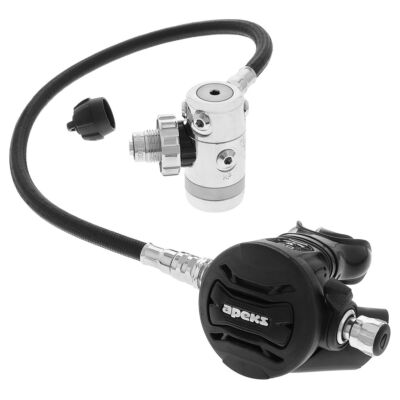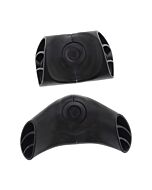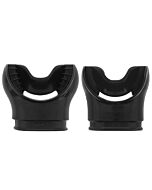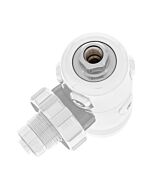DGX Custom - Apeks XTX Regulator
- Choose any Apeks XTX series over-balanced first stage
- Choose any Apeks XTX series pneumatically assisted balanced second stage
- Choice of second stage hose length and routing - right or left inlet orientation
- Ultra-performance - tested and EN250 certified to a depth of {660 fsw | 200 msw}
- Excellent cold water tolerance to {36°F | 2°C} and Nitrox Ready
DGX Custom - Apeks XTX Regulator
Regardless of your choices, you will receive the same ultra-performance breathing characteristics from any and all Apeks XTX Regulator configurations.
A popular choice of experienced technical divers worldwide, the Apex XTX series regulator is an ultra-performance model based on the Apeks the over-balanced diaphragm first stage and Apeks pneumatically assisted second stage. Choose any first stage paired with your choice any second stage - all choices deliver the same ultra-performance. This package is assembled by Dive Gear Express using Apeks brand first and second stages, together with our flex or rubber hose in your choice of length. The Apeks XTX ultra performance regulator is cold water and Nitrox Ready, tested and EN250 certified to a depth of {660 fsw | 200 msw}.
The Apeks XTX series first stages are an over-balanced, diaphragm design - as the diver descends, the over-balancing feature allows the intermediate pressure gas in the hose to increase at a rate faster than ambient resulting in superb performance at extreme depths. An environmental seal keeps water out of the main spring chamber thus preventing ice buildup and keeping silt and contamination out.
The Apeks XTX second stages are a pneumatically-balanced design that results in smooth, easy breathing. The purge button is large and easy to operate and features two-step progressive operation. Press the purge on the side for a lower flow rate, useful where more control is required such as filling lift bags, then press in the center for the full effect of the purge such as when clearing water. The large venturi lever has a soft touch rubber grip, which makes it easier to locate and use. A heat exchanger which surrounds the valve mechanism, dissipates the cold caused by gas expansion while drawing in the warmth of the ambient water.
| Brand | Apeks |
|---|---|
| SKU | PK-791002 |
| Weight | 7.000000 |
Customer Reviews
What is the knob and lever on my second stage?
The knob and lever are used to alter the breathing characteristics of some types of regulator second stages. All our downstream design high performance second stages, including the DGX Xtra and D6, Dive Rite XT2 & XT4, MaresXR HR, and the Apeks XTX200 & XTX50 include a knob to adjust inhalation cracking pressure (aka opening effort.) Some second stages, including the DGX Xtra and D6 along with the Dive Rite XT2 & XT4 and all the Apeks XTX Series, offer a lever to disable/enable venturi assisted inhalation. The Mares XR HR/VR/SXS stages use a unique Vortex Assisted Design (VAD) system that does not require a venturi lever. Upstream designs with a servo-assist valve, such as the Poseidon Xtreme, don't normally incorporate these features because the design inherently obviates most of the need for them. Many special application designs that are light duty, such as backup (aka 'octo', 'safe second', 'alternate', 'oxygen') and BCD integrated second stages, may omit the diver adjustable cracking pressure and/or the venturi assist features for the sake of simplicity.
The knob is for diver adjustment of the cracking pressure (aka opening effort) which is the inhalation force it takes to trigger the second stage valve to open and begin to flow breathing gas to the diver. Some people might refer to this as the 'breathing resistance' but this is a misnomer because once the gas starts flowing, adjusting the cracking pressure during inhalation will have minimal effect. On most high performance designs turning the knob all the way out (counter clockwise) will cause a slight hiss or dribble of free flowing gas and turning it all the way in (clockwise) will make it difficult to breathe from the regulator. Start by setting the knob in the middle of the adjustment range and then turn the knob to set the cracking pressure to your personal preference. Some divers will occasionally adjust it during the dive based on changes in their physical effort and depth, but most divers find a setting they like and never feel a need to change it. †
Many high performance second stage designs include a venturi assist feature that reduces breathing resistance by automatically increasing gas flow during inhalation. Regulators with the venturi assist enabled are prone to free flow if the second stage is not in the mouth. The venturi lever set in the pre-dive position (-) will substantially eliminate the tendency to free flow. Second stages in pre-dive mode WILL deliver breathing gas, but with some increased breathing resistance because the venturi assist feature has been disabled. On the primary second stage, you should push this lever in to the dive position (+) when you put the regulator in your mouth. On second stages not in the mouth during the dive the switch remains in pre-dive position; should circumstances require its use while in-water, once breathing from the regulator just switch the lever from pre-dive to dive mode.
The knob and the lever have related yet different functions, the knob determines how easy it is to start the breathing gas flowing to the diver and the lever determines how easy it is to maintain the breathing gas flow. Some lever designs are {predive| dive} with little or no range of adjustment to the venturi effect, however the adjustment knob by design always has a significant range of settings. Both can be set to minimize the possibility of free flow.
Some divers (especially those who use a breathing pattern called 'skipping') incorrectly believe that by using the adjustments to decrease the regulator performance they will conserve gas. In fact, improperly adjusted second stages have the opposite tendency to cause most divers to retain CO2 and increase their respiration rate thus gas usage while at the same time causing some discomfort and/or headache.
† You might be surprised to learn some experienced divers dislike having an adjustment knob on their second stage. They view the knob as an unnecessary option that is thought to be more of an entanglement hazard, certainly adds to the cost of the regulator and some just prefer a more streamlined second stage. Unnecessary? Yes, even when there is no external knob, the cracking pressure on downstream designs is always adjustable internally. This an easy skill to learn, beneficial to know, and there are videos on the internet to show you how.






